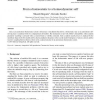Free Online Productivity Tools
i2Speak
i2Symbol
i2OCR
iTex2Img
iWeb2Print
iWeb2Shot
i2Type
iPdf2Split
iPdf2Merge
i2Bopomofo
i2Arabic
i2Style
i2Image
i2PDF
iLatex2Rtf
Sci2ools
BIOSYSTEMS
2008
2008
From a homeostatic to a homeodynamic self
Life as an autonomous homeostatic system is discussed. A mechanism that drives a homeostatic state to an autonomous selfmoving state is examined with two computational cell models. The mechanism is met with Ashby's ultrastability, where random parameter searching is activated when a system breaks a viability constraint. Such a random search process is replaced by the membrane shape in the first model and by chaotic population dynamics in the second model. Emergence of sensors, motors and the recursive coupling between them is shown to be a natural outcome of an autonomous homeostatic system.
| Added | 08 Dec 2010 |
| Updated | 08 Dec 2010 |
| Type | Journal |
| Year | 2008 |
| Where | BIOSYSTEMS |
| Authors | Takashi Ikegami, Keisuke Suzuki |
Comments (0)

